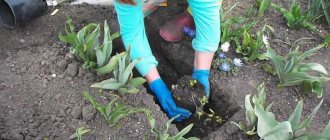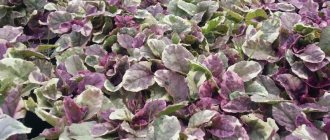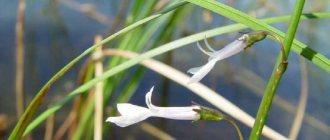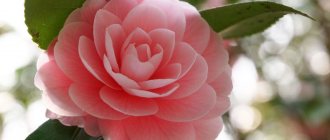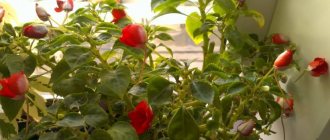At the end of the 16th century, in the countries of the tropical zone, a flower was found that was distinguished by incredibly beautiful, bright flowers of all kinds of colors. This flower is called Impatiens, which is translated from Latin as “touch-me-not.”
Subsequently, more than 500 species of flowers growing in the wild were discovered, which botanists united into a single family of Balsaminaceae. Beautiful flowers were transported to all corners of the planet and now each of us has the opportunity to admire colorful flower beds in parks and squares, in flower pots on balconies and windows, and in home pots on window sills.
Types of indoor balsam and popular varieties
There are about 400 species of Impatiens plant. The most popular types of balsam (impatiens) are useful for every gardener to study.
There are 4 main ones and several variety series that are popular in indoor culture. The same care is recommended. Basically, variations of the indoor perennial plant balsam differ from each other in appearance.
Waller's touch-me-not
The species stands out for its love of diffused light and sensitivity to touch. The bush can drop all its flowers due to a slight outside touch at a certain period. The plant is compact - usually no higher than 25 cm.
It has sharp oval leaves that are deep green in color. And the appearance of flowers depends on the subspecies. The flowers are quite large, with different variations of double size - from simple to lush roses.
Waller's impatiens, due to its beauty and ease of care, quickly became popular among gardeners. Therefore, breeders began to develop its varieties. This is how new additional varieties of balsam appeared.
Stardust
Stardust is a compact flower with large bright buds. This balsam with pink flowers is especially popular. They are large in size, bright pink with a slight white dusting on the petals.
Snow-white underside of the buds. The variety is distinguished by its resistance to pests. For example, he is not afraid of ticks.
Kandy
Balsams of the Kandy series were bred and went on sale not so long ago. The bushes of the plant consist of smooth and succulent stems, petioles with elongated oval leaves (their tip is pointed).
The culture blooms abundantly, the buds are bright, the flowers bloom simple and are located on high stems. The flowers are soft to the touch, with a delicate velvety surface. The variety is not demanding in care.
Tropical
Impatiens flowers of the Tropical variety are semi-double, beautiful with unusual colors. They are found in colors ranging from salmon (delicate) to bright coral.
This is a very popular variety in modern floriculture. It is more demanding in care than previous options, but also does not require special conditions. You can simply grow the crop on a windowsill in a small pot.
Fiesta
Terry balsam Fiesta is considered a universal species for indoor growing. Famous for its large, bright flowers in many shades.
The petals of the plant are terry and pleasant to the touch. The variety is easy to propagate. To do this, cuttings are cut throughout the season, which take root well at home.
New Guinea
Hawker's balsam, which grows wild in New Guinea, has become the source plant for the development of several varieties, which are called New Guinea hybrids. The culture has large flowers that bloom almost all year round. The elongated oval leaves have a rich color, often dark.
The plant is fast growing and larger than Waller's impatiens. It first appeared in Europe at the end of the 16th century and has not lost its popularity among gardeners since then.
Niamean
Niamey balsam has unusual flowers, shaped like beans. They can be yellow, red or two-color.
The variety is undemanding to lighting - perfect for growing in any window. During the period when the plant is not blooming, you can even place it in a shaded corner. And for high-quality flowering, it will already need a sufficient amount of light at least 4-5 hours a day.
Orchidaceous
Orchid balsam is an unpretentious indoor variety. It has a brittle deep pink stem with large green velvety leaves.
The main thing in caring for this variety is to water the flowers regularly, since they cannot tolerate either drying out or waterlogging of the soil.
Indoor flowering plants with a wide variety of varieties: indoor begonia, pelargonium, indoor gerbera, fuchsia.
Application in landscape design
Garden balsam is an ideal option for decorating the landscape; a continuous carpet of flowers of various colors and shapes will completely hide borders, ridges, and flower beds. It takes root well in indoor pots and flowerpots.
Designers use balsam as:
- balcony decoration;
- decor of terraces and gazebos;
- ground cover plant;
- decorations of flower beds and front gardens.
Diseases and pests
Yellowing, falling or wilting of balsam leaves indicates a possible disease. A long absence of flowering may also indicate this.
The flower can be bothered by whiteflies and spider mites. Pests attack the flower in insufficiently ventilated or too hot rooms. Special traps - sticky tapes hung over the pots - will help to partially cope with them. You also need to regularly clean whitefly eggs and larvae from the leaves and spray the plant with insecticidal solutions.
Moist and fresh air will drive away ticks from the balsam. The simplest and most effective measure is regular spraying of indoor flowers. The mite is afraid of humidity, while the balsam is moisture-loving.
If moss or mold is noticed on the ground in the pot, the top layer is removed and thrown away. This part is replaced with a new nutrient mixture of soil and sand.
Fading leaves and signs of rotting of the root system indicate that the soil in the pot urgently needs to be changed. The indoor flower is removed from the container and the roots are washed. The new soil should be water- and breathable, loose. If the root system is already severely damaged, then you will have to take cuttings from the plant.
Description
Garden balsam is a herbaceous plant with a height of 20 to 70 cm. It has narrow lanceolate leaves with serrated edges. The erect stem of garden balsam (pictured) is strewn with continuously blooming single, double or semi-double flowers. They are located at its top.
Balsam blooms from May to September, indoor specimens - until December
Most species have simple, irregularly shaped flowers about 10 cm in diameter, consisting of 5 petals. Some look like carnations, others like camellias, others like small roses.
Among the people, garden balsam is often called Vanka wet, Ogonyok, Impatiens. It received one of its names for the droplets of sweet nectar secreted by the leaves to attract insects. Outwardly, it seems as if the flower is crying. It is called the Light for its brightness and richness of color, and the Touch-me-not for the sensitivity of the seed pod. Even with a light touch to the ripe crowns, they crack and scatter seeds.
There are about 500 varieties of balsams, mostly growing in tropical and subtropical zones.
How to care for balsam at home
Any varieties of indoor balsam flowers are not picky to care for. An excellent option for beginning creators of home plant collections. The main thing is to understand the basic important conditions (features of lighting, watering, fertilizing, transplanting). Proper planting and care will allow the gardener to become the owner of a lush, beautiful, bright flower.
Illumination
Responsible care for balsam necessarily includes choosing a place for the flower in the apartment and lighting. It is best to place the pot with the plant on the window sill on the south side. At first, on sunny days, young bushes are covered with light curtains to prevent burns of the foliage. In very hot summers, it is advisable to move the flower to a western or eastern window sill. And during the rest of the year there is no point in protecting the plant from sunlight. The crop will not bloom in a very dark place. And light partial shade will be beneficial - the flowers will be brighter.
If the plant begins to stretch upward and the lower leaves fall off, this is a clear clue that the pot is located in the wrong place. In this case, you can wait for flowers only at the very top of the bush. It is necessary to choose a more comfortable place for the balsam and observe its behavior.
In the summer, it is recommended to place the flower on the balcony or outside so that it receives direct sunlight and fresh air. It is only important to ensure that the plant is not damaged by rain and wind.
Temperature
Indoor balsam loves warmth. In summer it is comfortable to grow at temperatures from +20 to +28 degrees. In winter, this figure can be reduced. It is optimal to maintain the room temperature at least +16 degrees. In the cold, the lights do not bloom and begin to slowly die.
Watering
When caring for balsam at home, it is easier to regulate watering than when growing it in open ground. The flower loves water, but it cannot be flooded. The soil in the pot should be constantly moist. For watering, it is worth preparing a bottle of water a day in advance so that it has time to settle. In summer, balsam needs a portion of water daily or every other day. In winter, the amount of watering is reduced by about 3 times.
It is necessary to regularly assess the condition of the soil in the pot. As soon as it dries 1 cm deep, the plant urgently needs watering. If a white coating is noticed on the surface of the earth, it should be softened and the alkalization process should be stopped. To do this, the top layer of soil is removed and a new one is filled in.
Top dressing
Fertilizers should be applied to pots with balsam from mid-spring to late autumn, repeating the procedure 2 times a month. In this case, special mixtures for fertilizing are selected, formulated for indoor flowers. They must contain potassium and phosphorus.
Terry balsams require nitrogen mixtures less often. They are introduced into the soil in the spring, as this speeds up the process of foliage growth. Excessive amounts of nitrogen can harm the plant. To determine the portion of such fertilizer for balsam, you should divide by 2 the amount recommended in the instructions for it.
Transfer
Balsam is one of those plants that should not be grown for years, replanting it annually in a new pot. Young bushes that are looked after for one or two seasons look more attractive.
But replanting will still be necessary when caring for indoor balsam at home. The bush grows and from month to month the nutritional value of the soil in the pot decreases. As a result, the leaves begin to fall off, the stems become elongated, and the flower looks and develops worse.
Transplanting the crop into a new pot will help avoid this. It should be more spacious so that all the roots of the plant and a small portion of fresh soil can completely fit in it. Excess shoots can be cut off during transplantation.
When moving the balsam into a new pot, it is carefully transferred along with the earthen lump. This should be done as carefully as possible so as not to damage the roots.
Afterwards, the plant is watered and a fresh portion of soil is poured into the container. The balsam will bloom again when it adapts to new conditions.
Planting methods
On the territory of Russia, planting and caring for garden balsam is carried out only with the onset of a warm period. The plant is planted in open ground no earlier than the air temperature rises to 20 °C.
There are 2 planting methods:
- planting seedlings;
- sowing method.
The shelf life of garden balsam seeds is approximately 8 years; by purchasing them once, you can provide yourself with seedlings for several years. Better germination can be achieved after 3-4 years of storage.
How to prepare seeds for planting?
Garden balsam seeds (photos of which are presented in the article) require careful care and proper preparation.
First of all, the seeds must be disinfected in a bright solution of potassium manganese or other liquid with disinfectant properties available on hand. The seeds are soaked in the solution for 15 minutes, then placed on a damp cloth to swell.
Several seeds are dropped into prepared, moistened holes and sprinkled with soil. The top of the soil is lightly sprayed and covered with cellophane. Under no circumstances should the soil be allowed to dry out or the temperature drop below 20 °C. After 1-1.5 weeks, when shoots appear, the film can be removed. In case of dense sowing, seedlings are pruned or thinned.
Possible growing problems
When caring for balsam at home, various problems may arise. So, in winter, a flower often freezes if it is located close to the glass of a window. In this case, it should be moved further away and placed where the plant receives heat from the radiator.
It happens that balsam leaves begin to lose moisture in the summer and dry out. In this case, you will need to measure the humidity in the room. It should remain within 40-60%. Even without special humidifiers, it can be raised to such levels by regular spraying from a spray bottle.
Balsam has many varieties, each of which has its own special advantages. Among them, any gardener will find the ideal option for himself. With minimal proper care, the plant will delight its owner with bright, beautiful flowers for many months. Impatiens is included in the Top flowering indoor plants.
Balsam propagation
The culture is propagated in two ways: cuttings and seeds. In the first case, the plant takes root very quickly. And in the second, you need to create a more complex soil mixture for the flower.
Propagation by cuttings
Indoor balsam is most often propagated by cuttings. In the process, it is enough to cut off part of the stem (7-8 cm), remove the lower leaves and send it into the water. Place the cutting in a glass in a warm and bright place. In about 8-9 days it will take root.
The soil mixture must be prepared consisting of five components in equal proportions: turf soil, leaf soil, humus, peat, sand. The soil should be loose and nutritious.
It is better to plant cuttings in pots several at a time - this will allow you to get a lush bush. A full flowering plant should be expected in a few months. All qualities of the mother variety are preserved.
Growing from seeds
When growing balsam from seeds, you will need to mix 1 part perlite and 2 parts peat. Flower seeds are scattered over the mixture, covered with a thin layer of earth and sprinkled with water. They are left under glass for the duration of germination at +22-25 degrees. It is important not to overwater the seeds. The best time to sow seeds is January.


